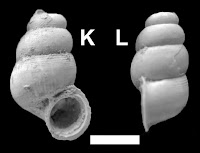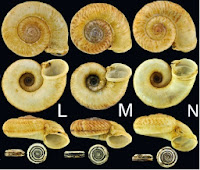Omalogyrid Snails are among the smallest known Gastropods, with
adult body sizes often comparable with larger Protozoans (single-celled
‘animals’). As such they tend only to be collected in surveys which directly
target them, rather than general surveys of Mollusc faunas, and are often
undocumented even in areas where other Molluscs have been studied extensively.
Omalogyrid Snails are not well studied, and neither relationships within the
group, nor the relationship of the group to other Gastropods are understood.
Neither is much known about the ecology or life-histories of these Snails,
though they are thought to all be algae consumers, and those species whose
reproductive behaviour and life cycles have been observed are hermaphrodites
(all individuals poses male and female sexual organs), with the young emerging
from the eggs as crawling larvae rather than a separate planktonic phase.
In a paper published in the journal Zootaxa on 7 October 2014, AndréSartori and Rüdiger Bieler of the Field Museum of Natural History in Chicago
describe three new species of Omalogyrid Snails from the southern West Coast of
North America, all of which are placed in the genus Ammonicera, from the collection of the Natural History Museum ofLos Angeles County.
The first new species described is named Ammonicera sleursi, in honour of Willy Sleurs of the Royal BelgianInstitute of Natural Sciences, for his work on Omalogyrid Snails. The species
is described from 92 specimens collected from locations at Mission Bay in San
Diego County, California, on the coasts of Jalisco and Baja California States
in Mexico, at depths of between 2 and 100 m. Ammonicera sleursi reaches about 0.7 mm in width and has a
disk-shaped shell, glossy and fawn on colour, with a broad spiral cord on the
early whorls of the shell, which disappears on the outer whorls (as the Snail
reaches maturity).
Ammonicera
sleursi. (A–B) Apical views; (A) general view; (B) detail
of the protoconch (interpreted boundary between protoconch and teleoconch at
arrowhead); (C–D) Umbilical views; (C) general view; (D) detail of the
protoconch; (E) dorsal view; (G) apical view, showing colouration; (F) apertural view;
(H) specimen from Los Arcos, apical view showing wide grooves between spiral
cords. Scale bars: (A, C, E–G) are 0.2 mm; (B, D, H) are 0.1 mm. Sartori &
Bieler (2014).
The second new species described is named Ammonicera mcleani, in honour of James McLean of the Natural
History Museum of Los Angeles County, an expert on eastern Pacific Gastropods,
who collected much of the material used in the study. The species is described
19 specimens locations in Baja California State in Mexico,
at depths of between 3 and 25 m. Ammonicera
mcleani reaches about 0.52 mm in width, and has a disk-shaped glossy amber
shell, with inner and outer spiral cords and 19-21 nodules around its outer
whorl.
Ammonicera
mcleani. (A–C) Apical views; (A) general view; (B) detail
of the protoconch; (C) colouration; (D–E) paratype 1, umbilical views; (D) general
view; (E) detail of the protoconch (interpreted boundary between protoconch and
teleoconch at arrowhead); (F) dorsal view; (G) apertural view. Scale bars: (A,
C, D, F, G) are 0.2 mm; (B, E) are 0.1 mm. Sartori & Bieler (2014).
The final new species is named Ammonicera
mexicana, in reference to where it was found. The species is described from
24 specimens, from Jalisco State, and the islands of Isabela and Roqueta on the
Mexican Pacific Coast, collected at depths of between 1.5 and 20 m. Ammonicera mexicana reaches about 0.57
mm in width, and has a disk-shaped, glossy, amber shell with central and outer
spiral cords and 14-20 nodules on its outer whorl.
Ammonicera
mexicana. (A–C) apical views; (A) general view; (B)
detail of the protoconch (interpreted boundary between protoconch and teleoconch
at arrowhead); (C) colouration; (D–E) umbilical views; (D) general view; (E) detail
of the protoconch; (F) dorsal view; (G) apertural view. Scale bars: (A, C, D,
F, G) are 0.2 mm; (B, E) are 0.1 mm. Sartori & Bieler (2014).
See also…
Toxoplasma gondii is a protozoan parasite that affects humans, and many other animals,
across the globe. While it causes disease in many organisms, it reproduces only
in Felids, particularly in Domestic Cats, with oocysts (egg-like cysts) being
shed in Cat faeces...
Jamaica is considered to be a biodiversity hotspot for Land Snails,
with over 505 species considered to be endemic to the island (i.e. coming from
the island and not found anywhere else) and 562 species found on the island in
total. This is despite the island having a...
Two new species of Cyclophoroid Land Snails from Thailand and Peninsula Malaysia.
Two new species of Cyclophoroid Land Snails from Thailand and Peninsula Malaysia.
The Cyclophoroidea are a large and diverse group of terrestrial
Gastropods, occupying a range of ecological niches from species that
live entirely below the soil surface to species that spend their entire
life cycles...
Follow Sciency Thoughts on Facebook.
Follow Sciency Thoughts on Facebook.






